Des Moines International Airport (DSM)
Des Moines International Airport (DSM) is a multi-use airport, located south of the city of Des Moines, Iowa, at the western edge of a large residential area. The airport's geographical location is said to make it a bit challenging for pilots to find at night. Utilizing all available navigation tools such as ILS, GPS, and VOR can make this challenge that much easier. The TWY system provides access to the services and businesses located on the airport. View a printable Pilot Handbook of the DSM information found on this Web page.
Know Before You Go
-
The RWY configuration consists of intersecting RWYs 5/23 and 13/31.
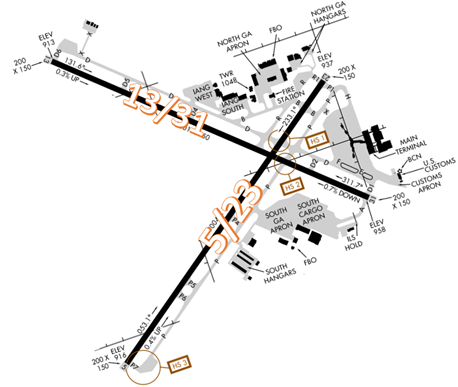
-
The airspace at DSM is Class C. (Refer to Sectional Chart)
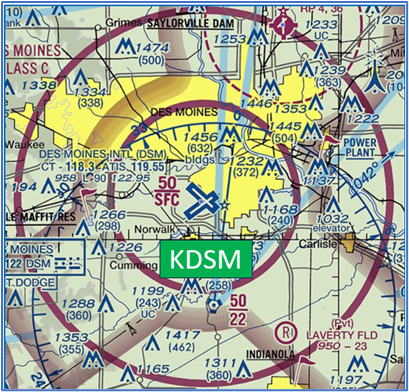
Below find various DSM-specific information and things to be aware of, as well as general information to inform your preflight planning. This will be reviewed quarterly and updated as needed. This information is to supplement the From the Flight Deck Videos that are produced by the FAA Runway Safety Group. Here you will also find information provided by the local air traffic controllers at the airport where you intend to fly. The information is subject to change. Not for navigation or legal* pre-flight action. Always refer to official pre-flight materials such as, but not limited to, NOTAMs, airport diagrams, VFR charts and airport construction notices for the latest airport-specific details.
DSM ATCT operates 24 hours
Administrative Office Open 0800L-1630L M-F
Business Phone 515-974-8010
Hot Spots
HS 1 Complex intersection area. Turns quickly lead to crossing RWY 5/23 at TWY D.
HS 2 Complex intersection area. Turns quickly lead to crossing RWY 13/31 at TWY P.
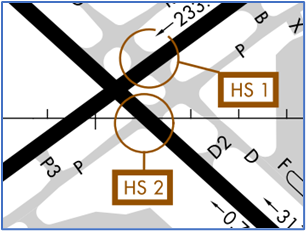 Both HS 1 and 2 essentially have the same issue: Pilots sometimes fail to hold short at the Hold Short Lines and enter the Runway Safety Area without a clearance, even after acknowledging the hold short instructions.
Both HS 1 and 2 essentially have the same issue: Pilots sometimes fail to hold short at the Hold Short Lines and enter the Runway Safety Area without a clearance, even after acknowledging the hold short instructions.- A contributing factor may be the close proximity of the RWY Hold Short lines to the TWY intersections.
- Surface painted markings, elevated signage and wig-wag lights are all present in this area to assist pilots with identifying the Hold Short position.
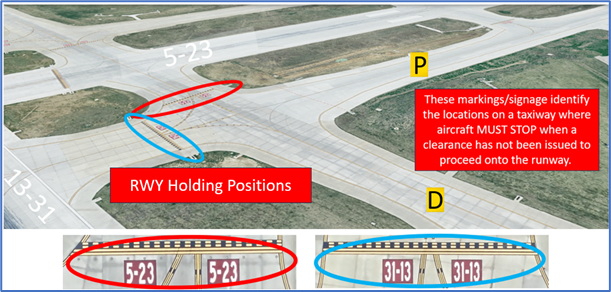
- Pilots should review the taxi clearance before starting to taxi. Actively scanning to locate and identify RWY signs, markings, and lighting and deferring all heads down activities until holding short at the appropriate location will help eliminate these errors.
- If you are ever unsure of your position or instructions, ask the TWR.
HS 3 RWY Incursion Risk. RWY 5 and TWY P7. RWY Holding Position Markings not visible from tower.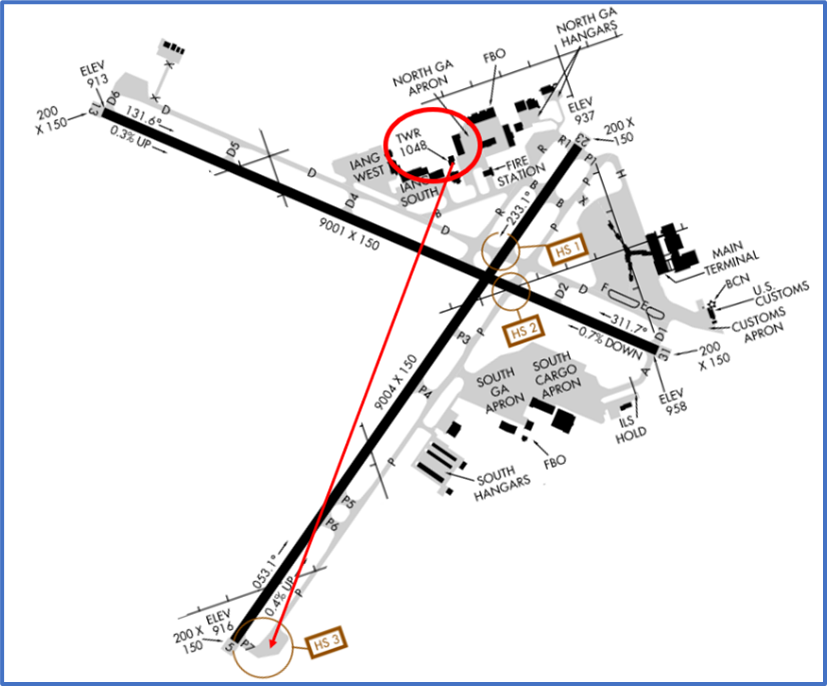
- HS 3 is located at the approach end of RWY 5. It is a long distance from the Tower and field geometry makes it very difficult for the controllers to see aircraft that are ready to depart.
- Pilots can help by only contacting the TWR when they are number one in sequence for takeoff or advising TWR of their sequence number on initial contact.
- If in doubt of your clearance, instruction, or location, do not hesitate to ask the TWR.
Wrong Surface Risk
- Whenever a TWY runs parallel to a RWY, the risk of landing on a TWY increases.
- DSM TWY P parallels RWY 5/23 and TWY D parallels RWY 13/31. Use caution when landing over raised lights in the over-runs and RWY thresholds.
- When available, back up all visual approaches with an instrument approach/GPS Waypoint to help ensure that you are lined up for the correct surface.
- RWY markings are white. Markings on surfaces not used for takeoff/landing like TWY markings, chevrons, RWY shoulder and RWY turn-on markings etc., are yellow.
- View the From the Flight Deck-Wrong Surface Landings video for mitigation strategies.
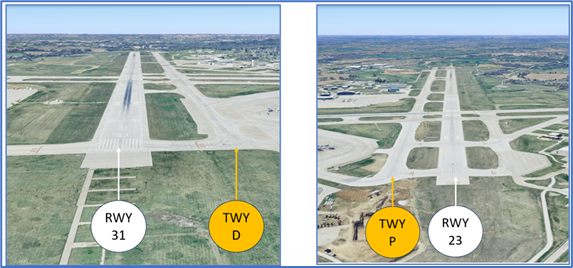
Wrong Direction Intersection Takeoff
- At DSM, or at any airport where intersection take-offs are authorized, there is the risk that pilots will turn in the wrong direction when entering the RWY.
- Aircraft issued an intersection departure RWY 5 at TWY P3/P4 have turned onto the RWY in the opposite direction and have departed or attempted to depart RWY 23.
- Prior to entering the RWY and again when lining up on the RWY, check your Magnetic Compass and, your Horizontal Situation Indicator (HSI), if installed, to verify that you are pointed in the correct direction.
- View the From the Flight Deck-Wrong Direction Intersection Takeoffs video for more information and mitigation strategies.
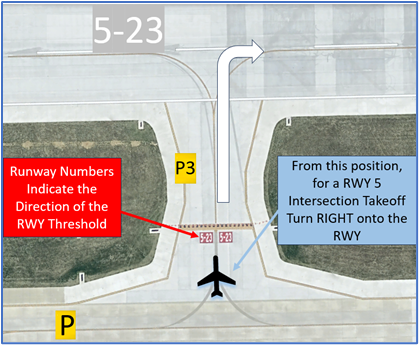
General
- Always communicate your intentions. If we know that you would like a touch and go rather than a full stop then it may drastically change our plan.
- If you are a student then please tell us, we are always happy to help if we know you need a little extra.
Traffic Patterns
- Be ready for changes. We have a very fluid operation, you may need to tighten your pattern, be ready to fly through final, change the direction of the pattern or hold depending on our rapidly changing traffic demands.
- We are always mixing propeller aircraft with commercial and business jets. This can be challenging for pilots and air traffic controllers!
Ground Control
- Study the airport surface before you arrive. If you are not sure what your instructions are then don’t go onto the runway.
- Multiple construction projects including FBO relocations are resulting in random taxiway closures. You may be issued a taxi route that you are not anticipating.
- Takeoff/Departure
- When necessary, we will give you an “immediate” take off or instruct “no delay”. This usually means that we have a jet arrival within 2 minutes of the threshold. Please advise the TWR prior to entering the runway if you are unable to perform an immediate departure.
Arrival/Landing
- Sometimes you will be sequenced closely behind another arrival. In fact, there may be two arrivals on the runway at the same time. Standard practice requires a 3000 ft. spacing between you and the previous arrival, if you are operating a small, single-engine propeller-driven aircraft. Your controllers are monitoring this.
- To improve safety, traffic flow, and orderliness for VFR aircraft arriving and departing DSM airport for the purpose of flight training, the DSM Air Traffic Control Tower, in collaboration with local flight schools, has developed practice areas and “transition fixes”. These unpublished practice areas and procedures are available to any pilot who desires to participate.
- Pilots are encouraged to review NOTAMS Letter to Airmen LTA-DSM-7 “VFR Practice Areas & Transition Fixes” for specific information including coordinates and graphics.
Additional Information
- Informal noise abatement procedures in effect. Expect ATC to assign preferred RWY.
- There is a lot of bird activity on and in the vicinity of the airport.
- The Iowa Air National Guard utilizes the ramp and service areas on the north complex.
- The south quadrant of the airport is the location of the large cargo ramp as well as some general aviation services. Air carrier ground operations are primarily found on the east side of the airport.
